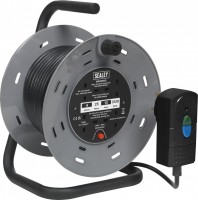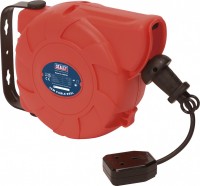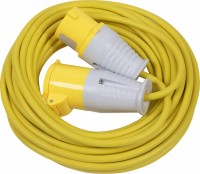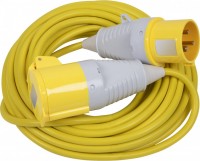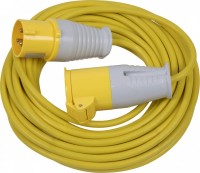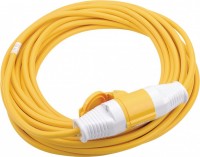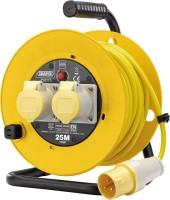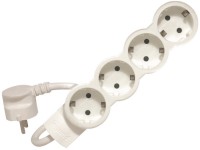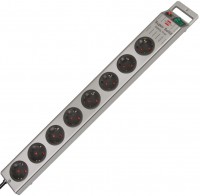Surge Protectors & Extension Leads Brennenstuhl
All models Advanced filters → |
You might be interested in
Articles, reviews, useful tips
All materials
Common battery types
Pros and cons of common types of batteries

How to calculate the battery life of home and computer equipment
How long will a conditional computer or refrigerator last from the UPS during power outages?

How to choose a surge protector
We consider from different angles the issues of protecting household appliances from too high or low voltage
Surge Protectors & Extension Leads: specifications, types
Show all
Product type
The general features of the design and application of the network filter depend on the type.
— Extension lead. Traditional extension cords designed to bring power to devices located far from outlets, as well as to increase the number of sockets themselves. They do not have built-in filters and provide almost no protection. On the other hand, such devices are extremely simple and inexpensive.
— Cable reel. Extension cords in which the wire is wound on a spool. They are significantly longer than models without coils; in addition, the user can adjust the length of the wire at his discretion. On the other hand, the weight and dimensions of such devices are also quite significant. As a result, extension cords on a reel are not well suited for home use, but may be indispensable for some specific tasks. For example, using such a device, you can stretch power through the yard of a private house, for work in a garage or a barn.
— H-frame extension lead. Extension cords in which the wire is wound around the frame — a special holder that resembles a double-sided horn. The design of the frame itself allows you to conveniently unwind and wind the power cord, while the wire is not subjected to twisting into knots and tangles. The extension cord on the frame usually has only one socket for connecting an electric current consumer.
— Roulette ex...tension lead. A kind of extension cord with a round body, in which the cord is wound in the manner as it is implemented in construction roulettes. In its upper part there are sockets (their number and type may differ), and on the reverse side there is a handle for returning the cord to the case. There is no automatic winding of the cord on the coil inside the case.
— Surge protected adapter. The simplest type of network filters are compact devices that are attached directly to the outlet. The possibilities of such devices are extremely simple: other connectors, in addition to ordinary sockets, are extremely rare in them, and the sockets themselves are usually provided with less than one (although exceptions are possible). On the other hand, small size in some situations can be an important advantage. In addition, such a filter can be constantly worn on the plug of the device with which it is used.
— Surge protector. Devices that combine the functions of a surge protector and an extension cord: allow you to connect electrical appliances to the network that are remote from outlets, while smoothing out the interference that occurs on the network. In addition, most models have several outlets, which allows you to connect several devices to one such filter at once. Note that models with 3-5 outlets are very popular as a means of connecting desktop PCs to a network: they allow you to power both the system unit and peripherals (monitor, speakers, printer, etc.) and additional devices like a table lamp from one outlet .
— Surge protector reel. Network filters equipped with a wire reel. According to the features of the application, they are completely similar to the extension cords on the reel described above, adjusted for the fact that in this case the device not only works as a remote outlet, but also protects the load from interference in the network.
— Extension lead. Traditional extension cords designed to bring power to devices located far from outlets, as well as to increase the number of sockets themselves. They do not have built-in filters and provide almost no protection. On the other hand, such devices are extremely simple and inexpensive.
— Cable reel. Extension cords in which the wire is wound on a spool. They are significantly longer than models without coils; in addition, the user can adjust the length of the wire at his discretion. On the other hand, the weight and dimensions of such devices are also quite significant. As a result, extension cords on a reel are not well suited for home use, but may be indispensable for some specific tasks. For example, using such a device, you can stretch power through the yard of a private house, for work in a garage or a barn.
— H-frame extension lead. Extension cords in which the wire is wound around the frame — a special holder that resembles a double-sided horn. The design of the frame itself allows you to conveniently unwind and wind the power cord, while the wire is not subjected to twisting into knots and tangles. The extension cord on the frame usually has only one socket for connecting an electric current consumer.
— Roulette ex...tension lead. A kind of extension cord with a round body, in which the cord is wound in the manner as it is implemented in construction roulettes. In its upper part there are sockets (their number and type may differ), and on the reverse side there is a handle for returning the cord to the case. There is no automatic winding of the cord on the coil inside the case.
— Surge protected adapter. The simplest type of network filters are compact devices that are attached directly to the outlet. The possibilities of such devices are extremely simple: other connectors, in addition to ordinary sockets, are extremely rare in them, and the sockets themselves are usually provided with less than one (although exceptions are possible). On the other hand, small size in some situations can be an important advantage. In addition, such a filter can be constantly worn on the plug of the device with which it is used.
— Surge protector. Devices that combine the functions of a surge protector and an extension cord: allow you to connect electrical appliances to the network that are remote from outlets, while smoothing out the interference that occurs on the network. In addition, most models have several outlets, which allows you to connect several devices to one such filter at once. Note that models with 3-5 outlets are very popular as a means of connecting desktop PCs to a network: they allow you to power both the system unit and peripherals (monitor, speakers, printer, etc.) and additional devices like a table lamp from one outlet .
— Surge protector reel. Network filters equipped with a wire reel. According to the features of the application, they are completely similar to the extension cords on the reel described above, adjusted for the fact that in this case the device not only works as a remote outlet, but also protects the load from interference in the network.
Cable length
The length of the cable used to connect the surge protector to the network.
The longer the cable, the farther from the outlet you can install the device. On the other hand, a long cable can be inconvenient over short distances. Models on a coil are deprived of this drawback (see "Type"), this moment is compensated by the actual presence of the coil, but they differ in large dimensions and heavy weight. So when choosing, it is far from always worth chasing the maximum length of the wire.
The longer the cable, the farther from the outlet you can install the device. On the other hand, a long cable can be inconvenient over short distances. Models on a coil are deprived of this drawback (see "Type"), this moment is compensated by the actual presence of the coil, but they differ in large dimensions and heavy weight. So when choosing, it is far from always worth chasing the maximum length of the wire.
Max. power
The highest power consumption of the connected devices that the surge protector can tolerate without consequences (to be more precise, with which it can work indefinitely without overloads, overheating, etc.).
This limitation is due to the fact that the higher the power at the same voltage, the higher the current passing through the equipment (in this case, through the surge protector); and off-design currents can lead to breakdowns and even accidents. And although in order to avoid these consequences, modern filters often provide various types of protection (see above), however, the operation of protection is still an emergency situation that is best avoided. Therefore, it is worth choosing a model according to this parameter in such a way that the maximum filter power is at least not lower than the total power consumption of the load. And it is best to have a margin of 20 – 30% — this will give additional guarantees in case of various deviations in the operation of the connected equipment.
Separately, it is worth highlighting the situations when the filter is planned to be used for the so-called reactive load — electrical appliances that widely use circuits on capacitors and/or inductors, for example, power tools or refrigeration units. The total power consumption of such devices (written in volt-amperes) can be much higher than the active power (which is indicated in watts). The recommended line filter power in such cases is calculated using special...formulas that can be found in the relevant sources.
This limitation is due to the fact that the higher the power at the same voltage, the higher the current passing through the equipment (in this case, through the surge protector); and off-design currents can lead to breakdowns and even accidents. And although in order to avoid these consequences, modern filters often provide various types of protection (see above), however, the operation of protection is still an emergency situation that is best avoided. Therefore, it is worth choosing a model according to this parameter in such a way that the maximum filter power is at least not lower than the total power consumption of the load. And it is best to have a margin of 20 – 30% — this will give additional guarantees in case of various deviations in the operation of the connected equipment.
Separately, it is worth highlighting the situations when the filter is planned to be used for the so-called reactive load — electrical appliances that widely use circuits on capacitors and/or inductors, for example, power tools or refrigeration units. The total power consumption of such devices (written in volt-amperes) can be much higher than the active power (which is indicated in watts). The recommended line filter power in such cases is calculated using special...formulas that can be found in the relevant sources.
Max. power (rolled cable)
Recommended maximum wattage with extension cable coiled. This item applies to coils and models on the frame, where the coiled cable can create an induction field and lead to serious trouble. The maximum load on an extension cord with a coiled cable should be significantly less than in a carrier with an unwound power cord, since the extension cord is exposed to heat when electricity passes through the coiled cable. In order to minimize the heating of coiled wiring, it is recommended to reduce the maximum load value by 50-60%. If the rated carrying power is 2100 W, then with a wound wire it is usually allowed to run a current of less than 1000 W through such an extension cord.
Max. load
The maximum current that the surge protector can pass through itself for an unlimited time without the risk of overheating, breakdowns and other troubles.
This parameter is directly related to the maximum power of the filter (see above): power is the current multiplied by the voltage. Thus, for example, for a standard 230 V model with a maximum power of 2200 W, the maximum load will be 10 A. Note that the characteristics of modern filters may not correspond to such calculations — for example, the same 10 A can be claimed for a 2500 W model . However, this is not something extraordinary: the difference in figures may be due to active and reactive power (see "Maximum power"), the characteristics of single-phase filters (without 400 V sockets, see above) can be given both for 230 V, so for 230 V and even 240 V, figures may be rounded for readability, etc.
Anyway, the practical value of the maximum load is the same as the maximum power: it should not be less than the current supplied to the connected electrical appliances (otherwise the protection may trip, or even break). And they use this parameter, along with the maximum power, because in some cases it is easier to evaluate the characteristics of the load (and filter requirements) in terms of current consumption, and not in terms of power.
This parameter is directly related to the maximum power of the filter (see above): power is the current multiplied by the voltage. Thus, for example, for a standard 230 V model with a maximum power of 2200 W, the maximum load will be 10 A. Note that the characteristics of modern filters may not correspond to such calculations — for example, the same 10 A can be claimed for a 2500 W model . However, this is not something extraordinary: the difference in figures may be due to active and reactive power (see "Maximum power"), the characteristics of single-phase filters (without 400 V sockets, see above) can be given both for 230 V, so for 230 V and even 240 V, figures may be rounded for readability, etc.
Anyway, the practical value of the maximum load is the same as the maximum power: it should not be less than the current supplied to the connected electrical appliances (otherwise the protection may trip, or even break). And they use this parameter, along with the maximum power, because in some cases it is easier to evaluate the characteristics of the load (and filter requirements) in terms of current consumption, and not in terms of power.
Max. energy absorption
The maximum energy absorption provided by the mains filter, namely, the maximum pulse energy at which the device can safely absorb and dissipate it, completely protecting the connected load. The higher this indicator, the more reliable the filter, the more powerful power surges it can handle. In inexpensive models, the maximum absorption is calculated in tens of joules, in the most advanced models it can exceed 1000 J and even 2000 J.
Wire section
The cross-sectional area of the wire used to connect the filter to the network. The larger the cross-sectional area, the thicker the wire, the more reliable it is and the more current it can pass without overheating. Accordingly, thick wires ( 1.5 mm² and 2.5 mm²) are a must for high power devices. At the same time, modern manufacturers, usually, choose the cross-sectional area in such a way as to guarantee the safe operation of the filter at the claimed maximum power (see above). Therefore, in fact, a model with a thicker cable than other similar devices should be chosen if it is supposed to be used in unstable networks in which power surges often occur. If the cross-sectional area seems too small for you ( 0.75 mm² or 1 mm²) for the claimed power, there are special formulas that allow you to check the validity of such doubts.
Operation indicator
The presence in the design of the surge protector of a special indicator (usually in the form of a light bulb) that indicates that the device is turned on.
This function provides the presence of at least one common indicator; and on models with switches per outlet (see below), additional indicators can be installed on the outlets. Anyway, such equipment makes working with the surge protector more visual, allowing you to immediately assess the status of the device and avoid some unpleasant situations (for example, imaginary equipment breakdowns — when a “faulty” device does not work just because the filter is not turned on).
The indicator can be installed directly in the switch (general or for each outlet, see the relevant paragraphs for details).
This function provides the presence of at least one common indicator; and on models with switches per outlet (see below), additional indicators can be installed on the outlets. Anyway, such equipment makes working with the surge protector more visual, allowing you to immediately assess the status of the device and avoid some unpleasant situations (for example, imaginary equipment breakdowns — when a “faulty” device does not work just because the filter is not turned on).
The indicator can be installed directly in the switch (general or for each outlet, see the relevant paragraphs for details).
Power switch
— Switch on the body. This function allows you to turn off the power to the load without disconnecting the filter itself from the mains — in other words, it eliminates the need to once again remove the filter plug from the outlet and insert it back. Most often, the switch controls all filter outlets, however, there are models where some of the connectors are bypassed and are always energized, regardless of the position of the switch.
— A switch for each outlet. This feature makes it easier to manage the power of connected devices: unplugging and plugging individual outlets is usually easier and faster than unplugging and plugging back in. Thus, electrical appliances used with such a filter can be kept constantly connected to it, turning off and on individual outlets as needed.
— Switch for each circuit. The function is used in models with numerous outlets. Allows you to simultaneously disable half of them, leaving the rest working. It combines the convenience of the points listed above and at the same time does not clutter up the device with unnecessary switches.
It is also worth noting that there are models that combine both a switch on the case and a switch for each outlet.
— A switch for each outlet. This feature makes it easier to manage the power of connected devices: unplugging and plugging individual outlets is usually easier and faster than unplugging and plugging back in. Thus, electrical appliances used with such a filter can be kept constantly connected to it, turning off and on individual outlets as needed.
— Switch for each circuit. The function is used in models with numerous outlets. Allows you to simultaneously disable half of them, leaving the rest working. It combines the convenience of the points listed above and at the same time does not clutter up the device with unnecessary switches.
It is also worth noting that there are models that combine both a switch on the case and a switch for each outlet.
Voltage indicator
According to the voltage indicator on the display, you can determine the readiness of the carrying to power consumers of electric current. Voltage indication is most often equipped with carrying with a surge protector.
Plug type
The type of plug (plug) used to connect the surge protector directly to the network.
— Normal. A traditional plug for sockets, which is standardly used in Europe and the post-Soviet space. The official name is CEE 7/4, or Schuko. If the filter is planned to be connected directly to a regular household network, you should pay attention to this type of plug. Also note that in models with 400V outlets (see below), a normal plug refers to a standard 400V plug.
— UPS (for UPS). A plug designed to fit into a three-prong IEC 60320 C13 socket, also known as a "computer socket". Such connectors are often found in uninterruptible power supplies, but they are practically not used as ordinary power outlets. Therefore, buying a filter with such a plug makes sense only if it is planned to be used in combination with a UPS.
— Normal. A traditional plug for sockets, which is standardly used in Europe and the post-Soviet space. The official name is CEE 7/4, or Schuko. If the filter is planned to be connected directly to a regular household network, you should pay attention to this type of plug. Also note that in models with 400V outlets (see below), a normal plug refers to a standard 400V plug.
— UPS (for UPS). A plug designed to fit into a three-prong IEC 60320 C13 socket, also known as a "computer socket". Such connectors are often found in uninterruptible power supplies, but they are practically not used as ordinary power outlets. Therefore, buying a filter with such a plug makes sense only if it is planned to be used in combination with a UPS.
Total sockets
The total number of sockets provided in the design of the filter.
In this case, the calculation takes into account all sockets — full-size CEE 7/4 ("Schuko"), "Eurocompact" CEE 7/16 and others (for more details on each individual type, see below). And data on the total number of sockets allows you to estimate how many plugs can be connected to the filter at the same time. Accordingly, it is worth choosing a model according to this indicator, taking into account the number of consumers that are planned to be powered through the filter. Of course, the limits on maximum power and current must also be taken into account (see below); on the other hand, "repeated" power strips are usually designed for the corresponding loads. Another point to keep in mind is that devices with a need for grounding should only be connected through the appropriate sockets (see below).
In this case, the calculation takes into account all sockets — full-size CEE 7/4 ("Schuko"), "Eurocompact" CEE 7/16 and others (for more details on each individual type, see below). And data on the total number of sockets allows you to estimate how many plugs can be connected to the filter at the same time. Accordingly, it is worth choosing a model according to this indicator, taking into account the number of consumers that are planned to be powered through the filter. Of course, the limits on maximum power and current must also be taken into account (see below); on the other hand, "repeated" power strips are usually designed for the corresponding loads. Another point to keep in mind is that devices with a need for grounding should only be connected through the appropriate sockets (see below).
Grounded sockets (type F)
The number of sockets with type F grounding, provided in the design of the mains filter.
In this case, we are talking about full-size European type F sockets with metal ground clamps on both sides at the edges of the socket. The "socket" in this case means a CEE 7/4 ("Schuko") standard plug. Grounding is required for the safe operation of some types of electrical appliances, in particular, washing machines and other machines that work with water, refrigerators, computers, audio equipment, etc. A detailed list can be found in the reference literature. If you plan to connect such devices through the filter, this filter must have sockets with grounding.
In this case, we are talking about full-size European type F sockets with metal ground clamps on both sides at the edges of the socket. The "socket" in this case means a CEE 7/4 ("Schuko") standard plug. Grounding is required for the safe operation of some types of electrical appliances, in particular, washing machines and other machines that work with water, refrigerators, computers, audio equipment, etc. A detailed list can be found in the reference literature. If you plan to connect such devices through the filter, this filter must have sockets with grounding.
Ungrounded sockets (type C)
The number of sockets without earthing type C, provided in the design of the mains filter.
In this case, it is assumed that the design of the power filter has a European type C socket (or several such sockets) without grounding. In this case, a "socket" means a CEE 7/4 ("Schuko") plug with two round holes in the central plane of the socket. It is worth choosing a model with this function only if the devices that you plan to use with the filter do not require grounding - otherwise, connecting to such an outlet may be unsafe.
In this case, it is assumed that the design of the power filter has a European type C socket (or several such sockets) without grounding. In this case, a "socket" means a CEE 7/4 ("Schuko") plug with two round holes in the central plane of the socket. It is worth choosing a model with this function only if the devices that you plan to use with the filter do not require grounding - otherwise, connecting to such an outlet may be unsafe.
Grounded outlets (Type E)
The number of sockets with type E grounding, provided in the design of the mains filter.
French Type E sockets use a two-hole pattern for the supply of electrical current and an integrated earth pin just above the center plane of the socket. Plugs for them are made with a characteristic hole for a grounding contact.
French Type E sockets use a two-hole pattern for the supply of electrical current and an integrated earth pin just above the center plane of the socket. Plugs for them are made with a characteristic hole for a grounding contact.
Grounded sockets (type G)
The number of sockets with grounding type G, provided in the design of the surge protector.
In this case, it is assumed that the surge protector contains one or more sockets of the new British type G. Such sockets are characterized by horizontal holes for flat power pins and a vertical hole for grounding.
In this case, it is assumed that the surge protector contains one or more sockets of the new British type G. Such sockets are characterized by horizontal holes for flat power pins and a vertical hole for grounding.
Ungrounded sockets (Type A)
The number of sockets without grounding type A, provided in the design of the mains filter.
American type A receptacles are available with two flat prong plugs. Due to the absence of a grounding contact, they are supposed to be used in conjunction with devices that do not require grounding.
American type A receptacles are available with two flat prong plugs. Due to the absence of a grounding contact, they are supposed to be used in conjunction with devices that do not require grounding.
Grounded outlets (Type B)
The number of sockets with earth type B provided in the design of the mains filter.
American type B receptacles are supposed to have two flat slots for power contacts and one semi-circular hole for grounding.
American type B receptacles are supposed to have two flat slots for power contacts and one semi-circular hole for grounding.
Compact
The number of "compact" sockets provided in the surge protector design.
The compact plug (CEE 7/16 standard) has a flat shape and two round contacts. It is used in electrical appliances that have low power and do not create a large load — in particular, chargers for portable gadgets. At the same time, such plugs are quite compatible with full-size "sockets" of the CEE 7/4 standard. Nevertheless, in the design of surge protectors, specialized sockets of the "compact" type can be provided: they take up little space and can be placed even on the "excess" of free space, which is too small for ordinary sockets.
Note that full-size "plugs" are poorly compatible with compact sockets. Such a plug can only be connected via an adapter, while it is worth remembering that compact sockets are designed for low load power. So it makes sense to specially purchase a surge protector with compact connectors only if you initially plan to connect devices with plugs of the same type to it.
The compact plug (CEE 7/16 standard) has a flat shape and two round contacts. It is used in electrical appliances that have low power and do not create a large load — in particular, chargers for portable gadgets. At the same time, such plugs are quite compatible with full-size "sockets" of the CEE 7/4 standard. Nevertheless, in the design of surge protectors, specialized sockets of the "compact" type can be provided: they take up little space and can be placed even on the "excess" of free space, which is too small for ordinary sockets.
Note that full-size "plugs" are poorly compatible with compact sockets. Such a plug can only be connected via an adapter, while it is worth remembering that compact sockets are designed for low load power. So it makes sense to specially purchase a surge protector with compact connectors only if you initially plan to connect devices with plugs of the same type to it.
Gadget Parking (GP)
The number of grounded Gadget Parking (GP) sockets provided in the filter design.
GP connectors have a round shape and three pairs of contacts, so that such a socket can be connected either to one standard (full-size) euro plug or two euro compact plugs at once (see above). This is especially convenient when charging various gadgets like smartphones or tablets: chargers for such equipment are often equipped with compact plugs, and two devices can be charged at once in each Gadget Parking connector. Grounding can also be useful when connecting a full-size Euro plug; for more information about it, see "Euro sockets with grounding".
GP connectors have a round shape and three pairs of contacts, so that such a socket can be connected either to one standard (full-size) euro plug or two euro compact plugs at once (see above). This is especially convenient when charging various gadgets like smartphones or tablets: chargers for such equipment are often equipped with compact plugs, and two devices can be charged at once in each Gadget Parking connector. Grounding can also be useful when connecting a full-size Euro plug; for more information about it, see "Euro sockets with grounding".
Three-phase sockets
The number of sockets for 400 volts provided in the design of the surge protector.
Three-phase 400 V networks are used to power high-power equipment — in particular, industrial units, some power tools, pumps, etc. In this regard, sockets of this standard are found exclusively in professional surge protectors and extension cords, most often made on a coil (see "Type") and designed for use on construction sites and other similar objects. Of course, such models are designed for connection to a 400 V network.
Three-phase 400 V networks are used to power high-power equipment — in particular, industrial units, some power tools, pumps, etc. In this regard, sockets of this standard are found exclusively in professional surge protectors and extension cords, most often made on a coil (see "Type") and designed for use on construction sites and other similar objects. Of course, such models are designed for connection to a 400 V network.
International plug
The number of universal sockets in the filter, compatible with several types of plugs at once.
Most often, such sockets are made compatible with three types of plugs: a standard “Euro plug” used in Europe and the post-Soviet space, an American Type A plug (two parallel flat contacts) and a Type I plug used in China and Australia (three flat contacts at an angle ). The filter for international plugs is useful for those cases when the household has equipment with different types of plugs — it will allow you to do without additional adapters.
Most often, such sockets are made compatible with three types of plugs: a standard “Euro plug” used in Europe and the post-Soviet space, an American Type A plug (two parallel flat contacts) and a Type I plug used in China and Australia (three flat contacts at an angle ). The filter for international plugs is useful for those cases when the household has equipment with different types of plugs — it will allow you to do without additional adapters.
Grounded sockets (type C13)
One or more 3-prong IEC C13 grounding sockets for connection to the UPS backup power filter. In the event of a power outage from the mains, consumer devices switch to power from a source with an emergency battery.
Grounded sockets (type C19)
The presence in the surge protector of sockets for a three-pin IEC C19 plug is an analogue of the C13 type (see above) with differences in the form of a rectangular shape without beveled corners and the location of the holes perpendicular to the connector axis. Such sockets are designed for increased current strength up to 16 A. They are also used to connect a surge protector to a backup UPS.
Phone jacks
The number of telephone jacks provided in the design of the filter.
The presence of such connectors means that the filter can also be used to protect the communication line from various interference. Such protection is especially important when sending faxes and connecting to the Internet over a telephone line — these types of communications are quite susceptible to interference. The minimum number of telephone jacks, if any, is 2, input and output. Many filters with this function have 3 connectors — an input and 2 outputs (to the phone and to the computer); There are more, but extremely rare.
The presence of such connectors means that the filter can also be used to protect the communication line from various interference. Such protection is especially important when sending faxes and connecting to the Internet over a telephone line — these types of communications are quite susceptible to interference. The minimum number of telephone jacks, if any, is 2, input and output. Many filters with this function have 3 connectors — an input and 2 outputs (to the phone and to the computer); There are more, but extremely rare.
Coaxial connectors
The number of coaxial connectors provided in the extension cord. If this is a traditional antenna signal, then only 1 connector is provided at each end of the extension cord (mother or father). If we are talking about connecting multimedia devices using an RCA connection, then there can be 2 or 3 connectors on each side of the cable.
USB A
The number of USB ports for charging, provided in the design of the surge protector.
Such ports do not perform any other function than powering and charging external devices such as smartphones or tablets. The presence of such connectors in the surge protector can be especially convenient when there is no “230-to-USB” adapter at hand, and there are few USB ports in a computer or laptop and using them for charging is “an unaffordable luxury”.
Such ports do not perform any other function than powering and charging external devices such as smartphones or tablets. The presence of such connectors in the surge protector can be especially convenient when there is no “230-to-USB” adapter at hand, and there are few USB ports in a computer or laptop and using them for charging is “an unaffordable luxury”.
USB C
The number of USB-C ports in the network filter design.
Such ports do not perform any other function than powering and charging external devices such as smartphones or tablets. The presence of such connectors in the surge protector can be especially convenient when there is no “230-to-USB” adapter at hand, and there are few USB ports in a computer or laptop and using them for charging is “an unaffordable luxury”.
Such ports do not perform any other function than powering and charging external devices such as smartphones or tablets. The presence of such connectors in the surge protector can be especially convenient when there is no “230-to-USB” adapter at hand, and there are few USB ports in a computer or laptop and using them for charging is “an unaffordable luxury”.
Max. charging current
The current output by a USB connector when a charging gadget is connected to it.
The higher the current, the faster the battery can charge. However, when choosing, note that in order to use a high current strength, the connected device must also support it. Basically there are USB with a current strength of 2.1 A, 2.4 A and 3 A.
It is also worth noting that when using several USB ports at the same time, the current strength is significantly reduced.
The higher the current, the faster the battery can charge. However, when choosing, note that in order to use a high current strength, the connected device must also support it. Basically there are USB with a current strength of 2.1 A, 2.4 A and 3 A.
It is also worth noting that when using several USB ports at the same time, the current strength is significantly reduced.
Power (with 1 device)
The maximum power that a USB port can produce when connecting only one gadget.
Higher power output speeds up the charging process. At the same time, there are a number of nuances associated with this parameter. Firstly, the appropriate power must be supported not only by the port, but also by the gadget being charged - otherwise the speed of the process will be limited by the characteristics of the gadget. Secondly, to take full advantage of the capabilities, you may need to support not only the appropriate charging power, but also a specific fast charging technology. Thirdly, in filters with several charging connectors, the maximum power per device can only be achieved if the other ports are not used.
Higher power output speeds up the charging process. At the same time, there are a number of nuances associated with this parameter. Firstly, the appropriate power must be supported not only by the port, but also by the gadget being charged - otherwise the speed of the process will be limited by the characteristics of the gadget. Secondly, to take full advantage of the capabilities, you may need to support not only the appropriate charging power, but also a specific fast charging technology. Thirdly, in filters with several charging connectors, the maximum power per device can only be achieved if the other ports are not used.
Charge current
Current value for all USB ports of the device. Allows you to understand how much maximum you can squeeze out of the device, i.e. how much current will be supplied to each port at maximum load. As for the maximum value of the current strength, it cannot be determined by this indicator.
Power output (all ports)
The total power provided by the device when charging through all USB ports simultaneously.
When assessing this parameter, two points should be taken into account. Firstly, when fully loaded, the power of each individual port may be below the maximum possible value. For example, some models with 2 USB ports of 3 A and 2 A (15 W and 10 W), with both ports operating simultaneously, can output only 10 W per each, that is, only 20 W in total (this is the number indicated at this point). Secondly, the power distribution across individual connectors may be different, depending on the current on each port and the supported fast charging technologies; It is best to clarify these nuances using official documentation.
When assessing this parameter, two points should be taken into account. Firstly, when fully loaded, the power of each individual port may be below the maximum possible value. For example, some models with 2 USB ports of 3 A and 2 A (15 W and 10 W), with both ports operating simultaneously, can output only 10 W per each, that is, only 20 W in total (this is the number indicated at this point). Secondly, the power distribution across individual connectors may be different, depending on the current on each port and the supported fast charging technologies; It is best to clarify these nuances using official documentation.
Protection
— Short circuit protection. Short circuit (short circuit) protection system — situations when the impedance in the circuit drops sharply, for example, due to a metal object falling between the socket contacts. It reacts to a sharp increase in current and opens the circuit, allowing you to avoid damage and fire equipment.
— Voltage drops protection. Protection against power surges in the network. A filter with this function is able to completely cut off power that exceeds the allowable rate set by the manufacturer, protecting the load from damage. Note that the surge protector is not able to replace a full-fledged stabilizer or voltage relay; however, in more or less high-quality networks that are not subject to strong fluctuations, a filter is quite enough.
— Overload protection. In this case, overload means a situation when the load power exceeds the values \u200b\u200ballowed for a given network filter. This situation is similar to the short circuit described above — high currents go through the filter; however, overload has its own specifics, so protection against it can be provided as a separate system. However, the principle of operation of such systems is classic: when the permissible power is exceeded, it turns off the power, preventing breakdowns and fires.
— Varistor protection. A kind of protectio...n against short-term power surges in the network, built on varistors — variable impedance resistors. The impedance of such a resistor under normal conditions is in the millions of ohms, but it drops sharply if the input voltage increases above a certain value. Due to this, in normal mode, the protection practically does not affect the circuit, and with a high-voltage pulse, excess energy “merges” through the varistor and dissipates in the form of heat. The ability of varistors to absorb energy is not infinite, therefore, to protect against overheating, the design usually provides for a temperature sensor with an automatic switch.
— Voltage drops protection. Protection against power surges in the network. A filter with this function is able to completely cut off power that exceeds the allowable rate set by the manufacturer, protecting the load from damage. Note that the surge protector is not able to replace a full-fledged stabilizer or voltage relay; however, in more or less high-quality networks that are not subject to strong fluctuations, a filter is quite enough.
— Overload protection. In this case, overload means a situation when the load power exceeds the values \u200b\u200ballowed for a given network filter. This situation is similar to the short circuit described above — high currents go through the filter; however, overload has its own specifics, so protection against it can be provided as a separate system. However, the principle of operation of such systems is classic: when the permissible power is exceeded, it turns off the power, preventing breakdowns and fires.
— Varistor protection. A kind of protectio...n against short-term power surges in the network, built on varistors — variable impedance resistors. The impedance of such a resistor under normal conditions is in the millions of ohms, but it drops sharply if the input voltage increases above a certain value. Due to this, in normal mode, the protection practically does not affect the circuit, and with a high-voltage pulse, excess energy “merges” through the varistor and dissipates in the form of heat. The ability of varistors to absorb energy is not infinite, therefore, to protect against overheating, the design usually provides for a temperature sensor with an automatic switch.
Rack mount
Server extension cables designed for rack installation. In addition to the special installation method, they are distinguished by solid power and an abundance of sockets. Naturally, for home needs, such models will not be appropriate, as evidenced by the inflated price.
Safety socket cover
The presence of protective shutters from children in the design of the surge protector.
Such curtains are shutters that cover the current-carrying parts of the outlet and restrict access to foreign objects (most often, curious children try to put such objects into the outlet — hence the name). The design of the dampers is most often such that they open only under the pressure of the plug, when two contacts press on the curtains at the same time.
Such curtains are shutters that cover the current-carrying parts of the outlet and restrict access to foreign objects (most often, curious children try to put such objects into the outlet — hence the name). The design of the dampers is most often such that they open only under the pressure of the plug, when two contacts press on the curtains at the same time.
Wall mount
Availability of fastening on a wall in a network filter design. Such fastening most often has the form of a characteristic eyelet (loops), designed to be put on a nail driven into the wall or other similar detail. And the installation on the wall itself is convenient in that the filter can be quite close to the user, and besides, it does not take up space on the floor (which, among other things, minimizes the risk of stepping on the device, damaging it during cleaning, etc.) .
Outlets location
Options for placing sockets on the body of an extension cord or surge protector.
- Along the hull. Devices with the layout of sockets in one slender line, which is extended along the entire body of the extension cord or surge protector.
- In 2 rows. A popular scheme with the arrangement of sockets in 2 rows is on both sides of the upper plane of the device housing.
- In a circle. This category includes all extension cords and surge protectors with sockets in the form of a full circle or a semicircle.
- On both sides of the body. Sockets on several side faces of the case are found in compact cube models and in advanced surge protectors with relocated sockets on both sides of the case, which makes it easy to connect a large number of consumer devices.
- Along the hull. Devices with the layout of sockets in one slender line, which is extended along the entire body of the extension cord or surge protector.
- In 2 rows. A popular scheme with the arrangement of sockets in 2 rows is on both sides of the upper plane of the device housing.
- In a circle. This category includes all extension cords and surge protectors with sockets in the form of a full circle or a semicircle.
- On both sides of the body. Sockets on several side faces of the case are found in compact cube models and in advanced surge protectors with relocated sockets on both sides of the case, which makes it easy to connect a large number of consumer devices.
Socket plugs
Placement of plugs in sockets of an extension cord or surge protector relative to the device case.
- at an angle. Seats with holes for plugs in such models are rotated at an angle of about 45 ° relative to the plane of the case. Such an option for placing plugs allows for convenient inclusion of plugs so that they do not interfere with each other and do not overlap adjacent slots.
— Parallel to the body (180°). The holes for the plugs in this layout are arranged in sockets parallel to the body of the extension cord or surge protector. Large plugs are included in them perpendicularly, i.e. at an angle of 90° from the side of the "tail" with a network cable in relation to the axis of the device body.
— Perpendicular to the body (90°). A fairly rare form factor that involves the placement of seats for a plug with a plug perpendicular to the axis of the device case. As a rule, openings at an angle of 90 ° relative to the housing are found in models for compact flat plugs and in surge protectors of atypical form factor. They can also coexist with sockets where the holes for the plugs are located at an angle.
- At an angle and parallel to the body. Combined variant of the layout of the holes for the plug, combining sockets with seating at an angle and parallel to the axis of the body of the extension cord or surge protector.
- At an...angle and perpendicular to the body. A variety of network filters and extension cords with different arrangements of holes in the mounting sockets. Most of them are placed at an angle with respect to the axis of the body, and one or more - perpendicular.
- at an angle. Seats with holes for plugs in such models are rotated at an angle of about 45 ° relative to the plane of the case. Such an option for placing plugs allows for convenient inclusion of plugs so that they do not interfere with each other and do not overlap adjacent slots.
— Parallel to the body (180°). The holes for the plugs in this layout are arranged in sockets parallel to the body of the extension cord or surge protector. Large plugs are included in them perpendicularly, i.e. at an angle of 90° from the side of the "tail" with a network cable in relation to the axis of the device body.
— Perpendicular to the body (90°). A fairly rare form factor that involves the placement of seats for a plug with a plug perpendicular to the axis of the device case. As a rule, openings at an angle of 90 ° relative to the housing are found in models for compact flat plugs and in surge protectors of atypical form factor. They can also coexist with sockets where the holes for the plugs are located at an angle.
- At an angle and parallel to the body. Combined variant of the layout of the holes for the plug, combining sockets with seating at an angle and parallel to the axis of the body of the extension cord or surge protector.
- At an...angle and perpendicular to the body. A variety of network filters and extension cords with different arrangements of holes in the mounting sockets. Most of them are placed at an angle with respect to the axis of the body, and one or more - perpendicular.
Protective cover
The sockets installed in the filter have additional protection against dust and moisture in the form of protective covers that cover the sockets during non-working hours. Note that its level can be different: relatively speaking, some models are able to endure falling under a downpour, others are designed for a maximum of accidental splashes. These details must be clarified according to the official documentation before use. Or in the Protection level item (see below).
Protection level
The degree of protection of electrical appliances is regulated by the international standard IP (International / Ingress Protection Rating). For power strip outlets, the most commonly used protection standards are IP20 and IP44.
Only ordinary household models do not have protection. Devices in the IP20 category have basic protection against dust, but they are not protected against moisture. Sockets rated IP44 and above are capable of withstanding both dust and moisture. Models of this class can be safely used in bathrooms and other rooms with a high level of humidity.
Only ordinary household models do not have protection. Devices in the IP20 category have basic protection against dust, but they are not protected against moisture. Sockets rated IP44 and above are capable of withstanding both dust and moisture. Models of this class can be safely used in bathrooms and other rooms with a high level of humidity.
Frost-resistant cable
Frost-resistant cable is relevant for extension cords that are used outdoors. The braid of the current-carrying wire in such carriers will not tan and crack in the cold. Resistance to low temperatures is due to the presence of heat-resistant components in the cable sheath.

